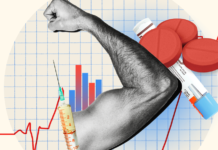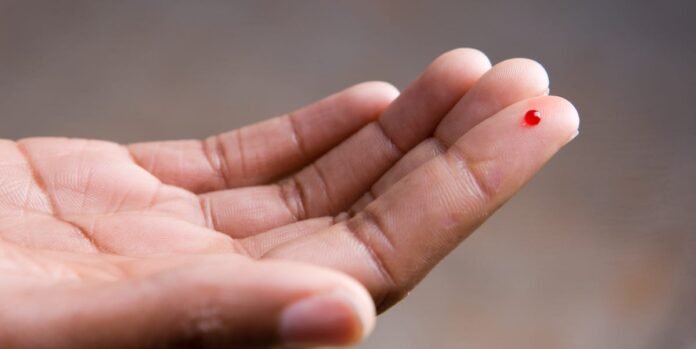There it was: a bulbous droplet of blood suspended from the tip of my left-hand middle finger, which was dangled over the lip of a microtainer. It was this droplet of blood, plus another 11 after it, that would tell me the level of testosterone in my body, and whether I’d qualify as a candidate for treatment.
As the online market for men’s wellness has grown, so too have the therapies offered by internet health startups—the same ones that sell drugs for erectile dysfunction and treatment for hair loss—for men interested in boosting their testosterone levels. As recently as 20 years ago, even men ages 15 to 39 had testosterone levels that were 20 percent higher. The most recent data of its kind estimates that nearly 40 percent of men over age 45 are certifiably low in testosterone, which generally means their level of the hormone is at or below 300 nanograms per deciliter of blood, the threshold established by the American Urological Association.
Although testosterone naturally decreases as we age, doctors who specialize in hormone therapy are noticing an uptick in the number of men who suffer from low or lower-than-average testosterone. They might be more irritable, fatigued, or depressed as a result. Their sex drive might be lower, or they might find it harder to put on muscle and keep off weight. In some cases, replacement therapy that replenishes the hormone through creams, gels, pellets, or injections is the right choice for fixing low T. In other cases, optimization—whereby the body generates more natural testosterone—does the trick.
The optimization route was the one I tried out in the middle of January when an at-home blood test from Roman arrived in the mail. (Full disclosure: In conjunction with the shopping guide on testosterone that Health AI Expert recently put together, Roman offered to send me one of its blood tests free of charge.) I filled out a series of questions online to get started, one that asked me a variety of things about my health: Was I experiencing muscle weakness? Did I feel tired in the afternoon? Once I got through the form, a Roman physician approved my blood test, which would tell Roman’s clinicians if my testosterone levels were low enough to be prescribed Clomid, a pill the company sells in several different dosages that stimulates more natural testosterone replacement.
What the blood draw is like
A cube-shaped box was shipped to my house about a week later. Inside were two smaller boxes with all the supplies I needed to take samples of blood over two consecutive days, along with instructions on how to set up the smartphone app that guided me through my blood draw. Roman takes two samples to check its work, essentially, and the directions for the draw don’t change from day to day. Of utmost importance: No eating or drinking, other than water, after 8 the night before each draw; and that each draw must be completed between 6 a.m. and 10 a.m., when your natural testosterone level is at its highest.
In about 15 minutes, I had the requisite amount of blood—more than 0.7 milliliters—deposited into the microtainer. It is pretty easy: You activate a small heat pad provided in each box to warm up your finger; you squeeze your fingertip using a tiny compressor device included in each box; you swab your fingertip with the included alcohol pad; and then, with a tiny lancet, you prick your finger and use the compressor to squeeze out drops of blood. (Roman even thought to include a bandage once you’re done collecting your blood.) When I was done with my second draw on a Friday morning, I put the microtainers back into their respective smaller boxes, placed the smaller boxes back into the cubed box, sealed it shut with an included sticker, and then dropped it off at the local UPS store. (Return postage is pre-printed on the box.)
How you get results
More fascinating were my actual results. By the following Tuesday, my blood test was processed, showing that my testosterone level is 594 nanograms per deciliter. On the Roman back-end, I set up a 15-minute phone call with a clinician, who walked me through my results and what he thought of them. (You can also get testosterone tests that don’t come with consultations. Discover more about those here.)
Thai-Hao Nguyen, M.D., told me my T level was “well, well within the normal range.” If I had come back below 350 ng/dL, we probably would’ve moved on to a conversation about prescribing Clomid. But I told him I didn’t feel any of the signs of low T, and given my number, he said taking Clomid didn’t really make much sense.
I asked him what he’d say to someone in my position, with the same testosterone level, who was feeling symptoms. “I’d say let’s start with your primary care physician and do the basics first,” he told me. That might mean screening for thyroid problems or diabetes, or getting a complete blood count, like you would during an annual physical, to identify any other potential problems.
It would also mean, he said, taking care of the basics as they relate to testosterone. That means getting at least seven hours of sleep a night. It means regular exercise. It also means watching your diet, and filling it with good sources of protein and fiber. It may be the case that, after doing all you can to optimize your testosterone level naturally, you need a boost. And that’s when someone would be able to reach back out to a Roman clinician and start Clomid, or to their own doctor to get another treatment and have it monitored.























